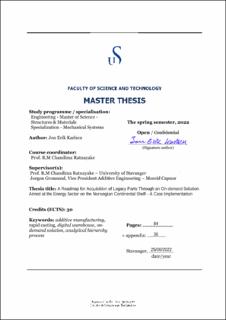| dc.description.abstract | \section{Abstract}
Equinor has initiated a Field Life Extension (FLX) project to prolong the end-life operational capabilities of their installations by innovative methods, including Stafjord A. One of these innovative methods is to implement an on-demand solution for re-supplying the installation with spare parts manufactured through alternative methods, such as additive manufacturing (AM) and rapid casting. However, due to the age of specific components, the documentation for design, material specification, and manufacturing may be missing, i.e., legacy parts.
The main aim of this thesis is to map the path from notification of a potential failure of a legacy part to the installation of a near-identical part. The life extension implies that mechanical equipment, such as valve bodies for the fire deluge systems must maintain their integrity throughout the expanded life cycle. Unfortunately, this component has exceeded its life expectancy by twice. Hence, increased degradation and risk for potential accidents introduce the need for acquiring new valve bodies.
A literature review investigated the challenges and requirements for implementing the on-demand solution for legacy parts. Standards and manufacturing methods have been studied and compared. An Analytical Hierarchy Process was used to analyze the input from experts within AM and rapid casting. Finally, a case review processed the valve body through the Reverse Engineering Process (REP) activities.
A roadmap is proposed based on regulations governing the manufacturing of mechanical components used on the Norwegian Continental Shelf (NCS). Furthermore, requirements for implementing the on-demand solution for legacy parts are described, including a proposition for an explicit criticality assessment for metal AM. A recommendation for operational part-monitoring and identification linked with a digital warehouse of the corresponding part is made to finalize the proposed roadmap for acquiring legacy parts on the NCS.
The Analytical hierarchy process (AHP) reveals that rapid casting outperforms metal AM for valve body manufacturing. In addition, metal AM and rapid casting are benchmarked regarding realistic cost and lead time procurement limitations. The results include the AHP output and indicate that the cost of ordering the valve body favour rapid casting, but the lead time for metal AM is lower than rapid casting. The total cost for metal AM per part is nearly equal to the cost of the initial requested batch of 26 valve bodies produced by rapid casting. | |
